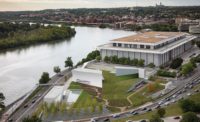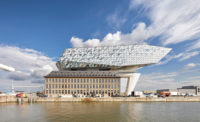The Hamburg IBA (for International BauAustellung, or “building exhibition”) is the latest iteration of a long-running German tradition: a showcase of experimental housing, intended to display new thinking in domestic architecture but built to be permanent and sold on the open market. In Hamburg's case, the aim was to demonstrate how the city could expand in a sustainable fashion into the relatively underdeveloped Elbe islands. These are separated from the city center by HafenCity, the docklands that are being transformed into a mixed-use neighborhood. The Soft House, by the KVA Matx team led by Boston-based Kennedy and Violich Architecture, couples a traditional solid softwood-construction technique with advanced technology, expressed in its architectural form.
The cross-section of a typical unit is L-shaped, with a deep ground floor giving way to shallower upper floors, providing each house a section of a shared second-floor terrace. The architects' aim was to allow for flexibility: the ground floor could be a workspace, for instance, entered from the rear, since exterior steel stairs provide separate access from the small front gardens to the terrace level.
The garden side of the Soft House is partially enclosed by the PV ribbons, which are mounted on a beefy steel armature rising from the terrace and tensioned by fiber- reinforced composite boards anchored at roof level. Servo motors rotate the ribbons to follow the course of the sun, while pistons adjust the overall geometry of the array, pulling it flat to the roof during high winds.
The shading and energy-generating ribbons allow the extensive use of south-facing glass, maximizing the penetration of daylight while minimizing heat gain and glare. In addition to the PVs, the Soft House has ground-source heat pumps, convection ventilation via an atrium, and heat recovery. These features, combined with super-insulation and triple glazing, produce a building that is so efficient it can export electricity. The brettstapel jointed softwood panel and deck construction also contributes to the building's green credentials: it sequesters carbon and, because it is exposed on the interior, serves double duty as both structure and interior-finish material. Since it is pegged together, without glue or nails, it can readily be recycled at the end of the building's life.
Although demonstration-housing enclaves are not always commercially viable, the German model seems to work well enough and includes some concessions to the demands of the market. For instance, these houses are organized in a familiar suburban layout with ample provision for cars, both in open-air lots and garages. Now that the exhibition is officially over, families are moving in; one of the houses at the end of the Soft House row is looking comfortably lived in, its terrace bedecked with potted plants and a bird feeder.
Perhaps the greatest achievement of the Soft House is that it feels like a very adaptable home rather than an experiment in ultra-insulation. “Although there are innovations of a technical nature in the Soft House, the most important innovation is that of creating a lifestyle experience for low-carbon living,” says Sheila Kennedy, KVA principal. “The infrastructure is not hidden,” she says. “It is transformed and made materially soft to take on a responsive, space-making role as part of the architecture.” As to the durability of this moving soft shell, time will tell how well it responds to the needs of residents and to changing technology.
Sunday Times, Riba Journal.
PeopleFormal name of building: Soft House Location: Hamburg, Germany Client: International BauAustellung (IBA); PATRIZIA Projektentwicklung GmbH Owner: PATRIZIA Projektentwicklung GmbH
Architect:
Personnel in architect's firm who should receive special credit: Architect of record: 360grad+ architekten
Engineers: Heating, ventilation & mechanical engineers: Buro Happold
Consultant(s):
Other: Soft house manufacturing consortium: Global Solar Energy, Inc; Svensson Global, AG; Philips Color Kinetics Headquarters; Philips Eindhoven Lighting; Automatic Devices Company, Inc.; L-tronics, Inc.; Holzbau Merkle; Textilbau Gmbh.
General Contractor:
Photographer(s): Size: 10,000 gross square feet Construction cost: $2.8 million Completion date: April 2013 |
Products
Structural system
Manufacturer of any structural components unique to this project:
Exterior cladding Precast concrete: Lithon Plus – Travertino Precast Concrete Terrace Pavers EIFS, ACM, or other: EIFS Moisture barrier: Polyethylene film vapor barrier and air tightness membrane
Other cladding unique to this project:
Roofing
Windows Shutters: Baier – “New York” Sliding Aluminum Shutters.
Doors Wood doors: Interior hollow core door paint grade Upswinging doors, other: Sectional upward-lifting, manually operated garage door with Trespa resin-panel cladding
Interior finishes
Special interior finishes unique to this project:
Energy
Photovoltaic system:
Add any additional building components or special equipment that made a significant contribution to this project: |










Post a comment to this article
Report Abusive Comment